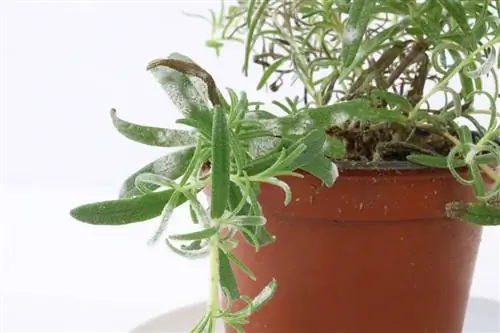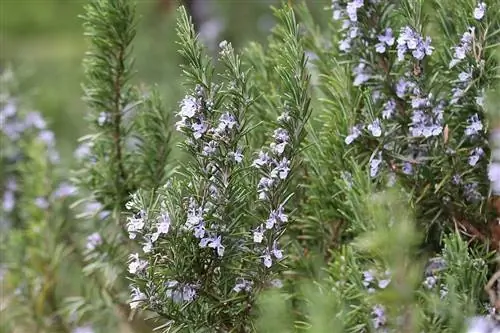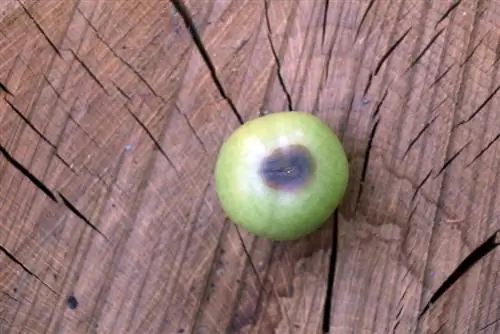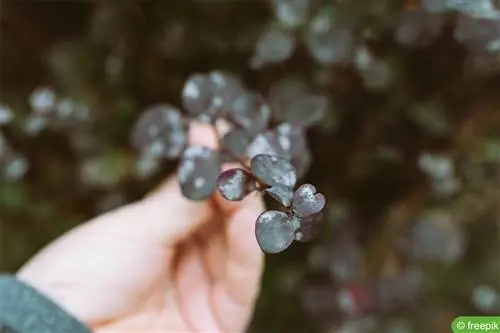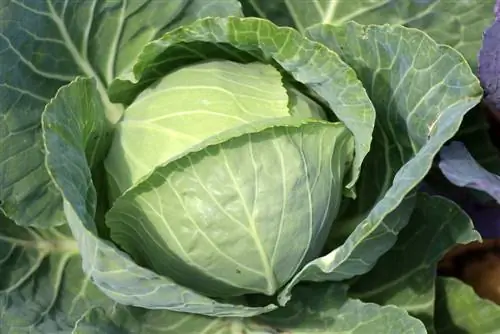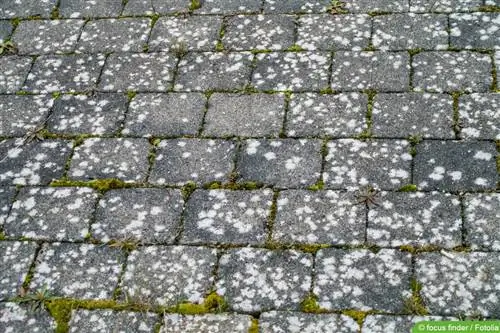- Author admin [email protected].
- Public 2023-12-17 03:39.
- Last modified 2025-01-24 12:45.
Rosemary is a popular culinary herb whose leaves are used in Mediterranean dishes because of their essential oils. Patchy discoloration indicates suboptimal conditions or is caused by fungal or pest infestation.
Adjust site conditions
The evergreen subshrub has its natural distribution area in the dry and hot regions of the Mediterranean. Rosemary is a survivor that thrives in barren locations and is heat tolerant. In the Mediterranean, the species grows predominantly in coastal regions and is an integral part of evergreen shrub vegetation known as maquis. It can also be found in shrub heath landscapes on shallow soils, the so-called garigues. If the microclimate is too humid or the place of growth is too cool, various problems such as spots on the leaves can occur. The first measure to improve disease progression and eliminate pests is to change location. In the garden, the culinary herb prefers the following conditions:
- full sun and wind-protected areas that offer a lot of warmth
- loose substrate that can be stony and calcareous
- moderately dry conditions
Avoid care errors
Rosemary's growth has adapted to the extreme climate in its natural distribution area. The evergreen plant benefits from winter rain periods. To protect itself against the hot and dry summer months, it has developed noticeably narrow leaves whose edges are curled downwards. The upper side is covered by a thick epidermis, while whitish to gray felt hair appears on the underside. These adjustments prevent the herb from losing too much water. If it is cared for incorrectly, the he alth of the plant will be impaired. Weakened plants are more susceptible to pathogens and insect pests that cause white spots. Therefore, you should pay attention to adapted care:
- don't allow waterlogging to occur
- Outdoor plants do not need any additional nutrients
- Potted plants enjoy occasional doses of liquid fertilizer
- basically avoid fertilization after August
- repot older specimens as little as possible
- At the end of March, cut back all previous year's shoots to short stubs
Tip:
Even if the herb prefers dry conditions, occasional watering makes sense. This ensures that the intense aroma is retained in the leaves.
Detecting fungal infestation
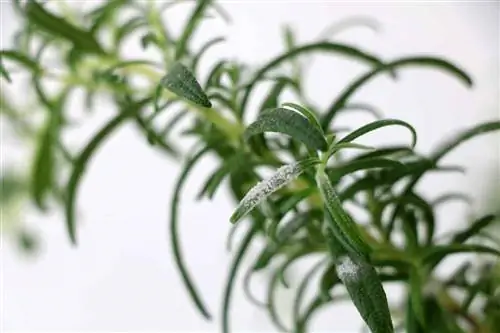
If the leaves have a mealy coating on the upper side of the leaf that can be easily wiped off with your finger, the plant is affected by powdery mildew. This fungal disease is particularly common in potted plants that are grown indoors all year round or are overwintered too warmly. Because mildew prefers warm, dry conditions, it is considered a fair-weather fungus. If the fungus spreads unhindered on the plant, it affects plant he alth. An untreated fungal disease can lead to excessive leaf loss because the fungal mycelium penetrates the leaf tissue and deprives it of nutrients.
Inject milk solution
A watery milk solution helps with mild mildew infestation. The lecithin it contains prevents the fungal network from penetrating the leaf cells. In addition, the lactic acid bacteria create an unfavorable environment in which the spores do not feel comfortable. Sodium phosphate strengthens the plant's defenses, so you can prevent re-infestation at the same time. For the greatest possible success, the entire plant must be sprayed while it is dripping wet, as the home remedy only works in direct contact. Follow these steps:
- mix fresh raw or whole milk with water (ratio 1:8)
- alternatively use whey or buttermilk
- Pour mixture into a spray bottle
- Spray rosemary two to three times a week
Use garlic tea
Garlic contains sulfur-containing compounds, which convert into allicin when the toes are cut. This substance has cell-killing properties and acts as a natural fungal poison. It is important that you spray all affected parts of the plant with the broth. Repeat the measure three to four times a week. How to make the extract:
- Press 50 grams of garlic cloves
- pour one liter of cooking water over it
- let it steep at room temperature for a day
- Dilute broth with water (ratio 1:10)
Note:
If the fungus has spread significantly, only a radical cut back usually helps. Fungicides based on neem oil are effective, but should not be used on culinary herbs.
Identify pests
Many insects have piercing mouthparts that they use to penetrate the pathways in plant tissue and feed on the sap. Discoloration occurs at these puncture sites, the intensity of which depends on the extent of the infestation. If a pest infestation is not controlled in time, the spots expand and merge with each other. The leaves dry out and fall off. These insect pests often occur on rosemary:
- Leafhoppers: ensure yellowish to white dotting on outdoor plants during the summer
- Spider mites: cause yellowish-white spots on potted plants in winter quarters
- Whiteflies: appear as white dots and leave yellowish discoloration on the underside of the leaves
Tip:
Leafhoppers are very agile and difficult to control because they quickly flee when they touch the plant. Spray the rosemary with a highly diluted vinegar essence, as this smell is off-putting.
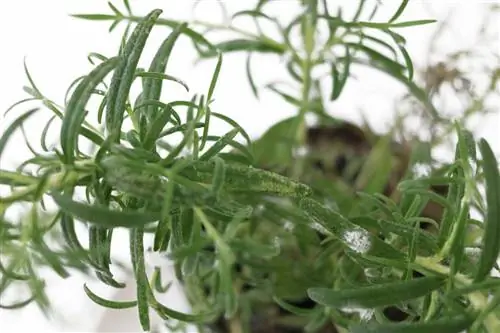
Inject rapeseed oil solution
Oil covers the insect pests like a film and clogs their breathing pores. Even the well-hidden eggs die due to lack of air. Since the oil particles get stuck in the stomata of the leaves, you should spray the treated plants vigorously with dishwashing water (mix water with dishwashing liquid) after a day. Reapply the product at regular intervals until the infestation disappears. This is what you need to keep in mind when making it:
- Mix ten milliliters of rapeseed oil with half a shot glass of dish soap
- Whisk with a hand blender and slowly add water
- mix until a total of one liter of tap water has been mixed in
- fill into a spray bottle and spray onto the affected parts of the plant with a fine atomizer
Spray soap solution
Similar to spraying with rapeseed oil-based mixtures, the soapy water forms an airtight film on the leaves. The addition of alcohol makes the substance more aggressive because it damages the outer skin of the insect pests and causes them to dry out. This product is gentler on the plant because the soap film decomposes quickly due to the effects of the weather and the alcohol evaporates quickly. This is how it's done:
- Dissolve 15 grams of soft soap in one liter of water
- Add 50 milliliters of alcohol
- fill into a spray bottle and spray on the plants
Tip:
Plant manure with nettle and field horsetail strengthens the cell tissue after spraying and has a small effect against the pests themselves.

